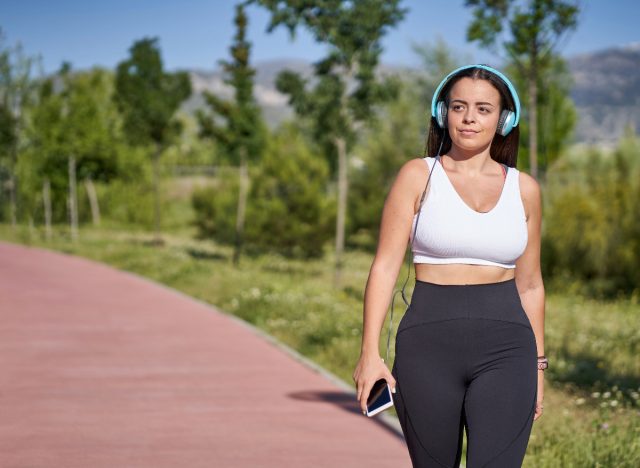This Simple Walking Plan Can Help You Melt Belly Fat
Walking has always been a favorite form of cardio for many. It’s convenient to do and there’s no equipment needed besides a solid pair of walking shoes. If walking is your go-to workout of choice, you’ll want to know about this simple, expert-approved plan that will help you log your steps while melting belly fat.
“Movement burns calories,” Emma Graves, certified personal trainer and studio instructor at Life Time, tells us. “In order to reduce body fat, we need to move. Walking is a superior form of cardio for fat loss because of its accessibility, versatility, and low intensity. Compared to other forms of cardio, walking has the lowest barriers to entry. We already do it in some capacity every day, and there are endless places that you can walk for no cost at all. Plus, walking outside may reduce stress and anxiety while improving your mood.”
When belly fat reduction is your endgame, be mindful that losing fat is a “whole-body process.” We’re sure you’d love to target that one stubborn area, but spot reduction is a myth. You need to work on your entire body in order to see visible results.
An Effective Weekly Walking Plan To Reduce Belly Fat

The start of any new workout plan requires realistic goals you’re passionate about. Every accomplishment, however small it may be, will motivate you to continue.
Start Slow and Work Your Way Up

Emma suggests starting slow with a 10-minute walk each day. Once you are used to that habit, increase the time to 20 minutes, then 30, and so on.
“The Department of Health and Human Services recommends at least 150 minutes of moderate aerobic activity per week,” Emma explains. “That said, needs will vary widely depending on your goals, your current activity levels, and your diet.”
Time Your Walks To Optimize Fat Burn

In addition, science says that walking is especially effective to do right after eating your meals when it comes to fat loss. Emma refers to them as “post-meal walks,” and encourages you to time your steps accordingly.
Be Mindful of Intensity

Staying on top of your walking intensity matters.
“The intensity at which we exercise plays a role in the ways our bodies change,” Emma explains. “Spending longer amounts of time in low-intensity, steady-state cardio (known as LISS) is shown to help with fat loss. Although walking burns calories at a slower rate compared to forms of high-intensity cardio (like sprinting), each of these forms of cardio use stores within our bodies to power the exercise.”
During LISS, the body burns fat stores as its main fuel source.
Establish a Calorie Deficit

In order to achieve noticeable changes, it’s necessary to establish a calorie deficit. What does that mean? Torching more calories than you consume.
“A general rule is that, over time, 3500 calories of a deficit will equal about one pound of weight loss,” Emma notes. “In practice, this could be a 500-calorie deficit each day for a week to lose one pound. However, the human body is very complex, so this is best used as a starting point, not the be-all-end-all.”
